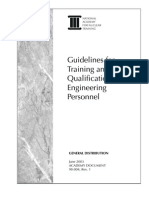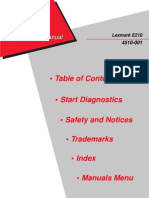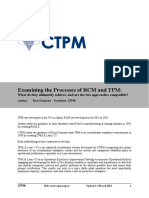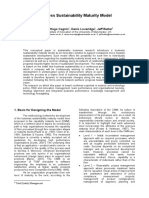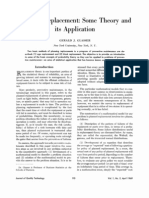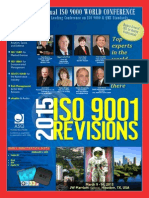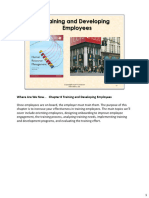0 ratings0% found this document useful (0 votes)
38 viewsMBTF vs. Oee
MBTF vs. Oee
Uploaded by
yoratenallThe document discusses two metrics for measuring equipment performance: overall equipment effectiveness (OEE) and mean time between failures (MTBF). OEE measures productive use of time while MTBF measures average time before failure. Either can provide insights but OEE includes more factors and is generally more useful for improving manufacturing processes.
Copyright:
© All Rights Reserved
Available Formats
Download as PDF, TXT or read online from Scribd
MBTF vs. Oee
MBTF vs. Oee
Uploaded by
yoratenall0 ratings0% found this document useful (0 votes)
38 views10 pagesThe document discusses two metrics for measuring equipment performance: overall equipment effectiveness (OEE) and mean time between failures (MTBF). OEE measures productive use of time while MTBF measures average time before failure. Either can provide insights but OEE includes more factors and is generally more useful for improving manufacturing processes.
Original Description:
Overall effectiveness vs. Mean time between failure
Original Title
MBTF VS. OEE
Copyright
© © All Rights Reserved
Available Formats
PDF, TXT or read online from Scribd
Share this document
Did you find this document useful?
Is this content inappropriate?
The document discusses two metrics for measuring equipment performance: overall equipment effectiveness (OEE) and mean time between failures (MTBF). OEE measures productive use of time while MTBF measures average time before failure. Either can provide insights but OEE includes more factors and is generally more useful for improving manufacturing processes.
Copyright:
© All Rights Reserved
Available Formats
Download as PDF, TXT or read online from Scribd
Download as pdf or txt
0 ratings0% found this document useful (0 votes)
38 views10 pagesMBTF vs. Oee
MBTF vs. Oee
Uploaded by
yoratenallThe document discusses two metrics for measuring equipment performance: overall equipment effectiveness (OEE) and mean time between failures (MTBF). OEE measures productive use of time while MTBF measures average time before failure. Either can provide insights but OEE includes more factors and is generally more useful for improving manufacturing processes.
Copyright:
© All Rights Reserved
Available Formats
Download as PDF, TXT or read online from Scribd
Download as pdf or txt
You are on page 1of 10
OEEOverall Equipment Effectiveness
vs.
MTBF Mean Time Between Failure
Which is Right for You?
Measuring the Performance of
Your Assets
If you have had some exposure to the common
thinking on this topic, then you are likely familiar
with the terms OEE (Overall Equipment
Effectiveness) and MTBF (Mean Time Between
Failure).
Both metrics can be very informative and drive
specific behaviors when applied correctly. When
applied incorrectly, they can lead to confusion and
frustration. In this post, I hope to shed some light on
which of these measures may be more meaningful
for your organization.
Overall Equipment Effectiveness (OEE)
OEE measures the percentage of manufacturing time
that is truly productive.
Perfection at OEE is 100%. Perfection means that you
are running as fast as possible during planned
(allocated) production time with no defects. Anything
more than that, and you are breaking a few of the
basic laws of physics, but we will save that discussion
for another time.
Common OEE Formula
• OEE = Overall Equipment Effectiveness
• A = Availability = The ratio of the run time to planned production time.
• R = Production Rate = The actual production speed compared to the ideal
cycle time.
• Q = Quality Rate = For all the units that you produced, what percentage of
them were acceptable for sale to the customer, meeting the stated quality
requirements.
OEE is a fantastic measure for a few important
reasons:
• Nowhere in the definition do the words “maintenance” or
“operations” appear. It facilitates two teams who can easily
work at cross-purposes together.
• It forces us to focus on the loss of potential rather than what
we have accomplished with no idea of what might be
possible.
• It brings together three aspects that are critical to meeting our
customers' needs.
• It provides insights into how to improve your manufacturing
process.
OEE is a bit of a universal metric; measuring it is a
manufacturing best practice. It includes many of the
critical aspects of your performance into a single
metric. If you include some safety and cost measures,
you are approaching a well-formed maintenance
scorecard.
Mean Time Between Failures (MTBF)
MTBF tells us the average time we should expect to
see an asset fulfill its designed function before
experiencing a failure. Higher MTBF performance is
better, as it indicates that your asset performs its
intended function longer without any interruption
attributed to failures.
Those who experience low MTBF should expect to see
higher levels of unplanned downtime, higher repair
costs, and possibly an associated increase in labor
costs. All attributed to the repairs that are required on
a more frequent basis.
MTBF can be used in conjunction with mean time to
repair (MTTR) to calculate system availability.
Calculating MTBF is relatively simple:
MTBF = (# of Assets X Time Frame) / # of Failures in
that time frame
• Number of Assets = Total Count of Assets, generally grouped by
some approximation of asset type (pumps, rotating equipment,
motors, etc.) in a specific area of focus (plant-wide, department,
operating area, etc.).
• Time Frame = Frequency of measurement – usually monthly or
annually.
• Number of Failures = The number of occurrences where the asset
failed to fulfill its function.
MTBF is a relative measure. Measuring MTBF on a
highly critical asset or group of assets can be very
meaningful. Measuring MTBF across an entire
department or facility provides a little less value but is
still informative with regard to our ability to maintain
our assets. Increasing MTBF means we are doing
something right.
It is also important to note that MTBF does not
consider situations where assets are running at a
reduced rate, nor does it consider the size and
duration of the event (not all equipment failures are
equal – some are longer and have a greater impact
than others).
Why Calculate MTBF?
MTBF is a valuable metric that helps organizations
ensure that their maintenance strategy is delivering
reliability, availability, and performance of their systems
and products, ultimately leading to improved customer
satisfaction and operational efficiency.
How to Improve MTBF
1. Component Selection
2. Redundancy
3. Preventive Maintenance
4. Monitoring and Diagnostics
5. Design Improvements
6. Training and Personnel Development
7. Environmental Control
8. Supplier Quality Control
9. Continuous Improvement
By implementing these strategies, organizations can
enhance the reliability and performance of their
systems or components, leading to increased MTBF
and improved operational efficiency.
Which is right for you?
OEE or MTBF?
Metrics are a funny thing. When used correctly and
with the right application, they can provide a lot of
value and focus to an organization. Used incorrectly,
they tend to cause more harm than good.
When selecting the best metrics for your team,
consider the following advice:
• Keep it simple. Too many measures cloud the focus.
• Make sure we know what actions to take to improve
the performance of each metric. What must we do
differently to improve? It sounds obvious, but
surprisingly it is often overlooked.
• Talk about it often. A metric is only as good as the
leader who draws the team together to own it and
acts on it.
Did You Find This Helpful?
Allied Reliability provides asset management consulting and
predictive maintenance solutions across the lifecycle of your
production assets to deliver required throughput at lowest
operating cost while managing asset risk and achieving
environment, social, and governance objectives.
For resources and more, follow us on our social media
channels and visit our website.
alliedreliability.com
You might also like
- Case NoteDocument4 pagesCase NoteAbhilash Reddy60% (5)
- IbmDocument6 pagesIbmhoangminh87No ratings yet
- Acad98 004R1Document66 pagesAcad98 004R1michael1971100% (1)
- Lexmark E120 Service Manual 4510-001Document74 pagesLexmark E120 Service Manual 4510-001Marcus LeeNo ratings yet
- Dispute Between A Man and His Ba - TranscribedDocument12 pagesDispute Between A Man and His Ba - TranscribedCarrie Arbuckle100% (1)
- The Rhetoric of Malcolm XDocument13 pagesThe Rhetoric of Malcolm Xgideon mbathaNo ratings yet
- Highly Reliable Organizations: What Are They and What Traits Do They Display?Document34 pagesHighly Reliable Organizations: What Are They and What Traits Do They Display?Namita RazdanNo ratings yet
- The EU AI Act A Pioneering Effort To Regulate Frontier AIInteligencia ArtificialDocument10 pagesThe EU AI Act A Pioneering Effort To Regulate Frontier AIInteligencia ArtificialamcsettaigalNo ratings yet
- Jamieson - Short Interval ControlDocument15 pagesJamieson - Short Interval ControlAlejandroZappaNo ratings yet
- ISO 55000 and The BenefitsDocument39 pagesISO 55000 and The BenefitsAhmed SaeedNo ratings yet
- Visual WorkplaceDocument56 pagesVisual WorkplaceMadhavaKrishnaNo ratings yet
- Compass ISO 55001 Assets ManagementDocument7 pagesCompass ISO 55001 Assets ManagementaodyNo ratings yet
- Examining RCM Vs TPMDocument16 pagesExamining RCM Vs TPMcarrot123456No ratings yet
- Sustainabilty Maturity ModelDocument15 pagesSustainabilty Maturity ModelbusinellicNo ratings yet
- OD Applications:: Application of OD in Business EnterprisesDocument4 pagesOD Applications:: Application of OD in Business EnterprisesJitendra KumarNo ratings yet
- 1-Procedure Based MaintenanceDocument14 pages1-Procedure Based MaintenanceJose Luis RattiaNo ratings yet
- Quality Management Evolution From The Past To PresDocument30 pagesQuality Management Evolution From The Past To Pressydneyallan88100% (1)
- ISO 55001 Self Assessment WEB AUDocument4 pagesISO 55001 Self Assessment WEB AULeohnasNo ratings yet
- WPC Vantage Point - Creating A Culture of Operational Discipline That Leads To Operational ExcellenceDocument12 pagesWPC Vantage Point - Creating A Culture of Operational Discipline That Leads To Operational ExcellenceWilson Perumal & CompanyNo ratings yet
- Ventyx-ABB Asset Health CenterDocument23 pagesVentyx-ABB Asset Health CenterAndy L Quezada OrdoñezNo ratings yet
- AAMCoG Guide To Integrated Strategic Asset ManagementDocument24 pagesAAMCoG Guide To Integrated Strategic Asset ManagementNamita SinhaNo ratings yet
- Implementing Iso 55000 For Small or Immature Organisations: Rolan Moodley, Jacobs Consulting Pty LTDDocument6 pagesImplementing Iso 55000 For Small or Immature Organisations: Rolan Moodley, Jacobs Consulting Pty LTDSk IslamNo ratings yet
- Pinnacle - Quantitative Reliability Optimization (QRO) Executive BriefDocument9 pagesPinnacle - Quantitative Reliability Optimization (QRO) Executive Briefmohamed al-amir100% (1)
- Meridium APM Now: Questions?Document2 pagesMeridium APM Now: Questions?SANDRA TORRESNo ratings yet
- Insights To Action: Eliminating Process and Organizational ComplexityDocument1 pageInsights To Action: Eliminating Process and Organizational ComplexityWilson Perumal & Company0% (1)
- LCE Risk-Based Asset Management ReportDocument11 pagesLCE Risk-Based Asset Management ReportPola7317No ratings yet
- Mbo 01Document63 pagesMbo 01Omairullah KhanNo ratings yet
- Substation PM and PDM Program Assessment PDFDocument5 pagesSubstation PM and PDM Program Assessment PDFho-fa100% (1)
- Data Management Maturity: Assessment ReviewDocument44 pagesData Management Maturity: Assessment ReviewSajeedNo ratings yet
- High Reliability Organizations - Sutcliffe - 2011 PDFDocument12 pagesHigh Reliability Organizations - Sutcliffe - 2011 PDFjoaquingarcilazoNo ratings yet
- Asset Management Decision Support Modelling Using Health and Risk ModelDocument6 pagesAsset Management Decision Support Modelling Using Health and Risk ModelTobiasNo ratings yet
- Strategic Planning: By: Charisa Lea M. OmongosDocument24 pagesStrategic Planning: By: Charisa Lea M. OmongosCharisa Lea OmongosNo ratings yet
- Asset Management Plan 20141215 103723 6434 PDFDocument5 pagesAsset Management Plan 20141215 103723 6434 PDFLachy FentonNo ratings yet
- RICKY SMITH-Evolution From Lean Manufacturing To Lean ReliabilityDocument25 pagesRICKY SMITH-Evolution From Lean Manufacturing To Lean ReliabilityosbertodiazNo ratings yet
- Accenture Point of View On Human Capital Performance ManagementDocument6 pagesAccenture Point of View On Human Capital Performance ManagementDikkaRamadhanNo ratings yet
- Calculating ROIDocument5 pagesCalculating ROIMuhammad FaisalNo ratings yet
- Change Management ThoriesDocument7 pagesChange Management ThoriesArsalan AhmedNo ratings yet
- An Evolutionary Model of Continuous Improvement Behaviour: John Bessant, Sarah Caffyn, Maeve GallagherDocument11 pagesAn Evolutionary Model of Continuous Improvement Behaviour: John Bessant, Sarah Caffyn, Maeve GallagherNathalia Cáceres100% (1)
- Books 2008Document4 pagesBooks 2008Arvind KumarNo ratings yet
- Adding Enterprise Analytics: To Your ERPDocument7 pagesAdding Enterprise Analytics: To Your ERPpartho143No ratings yet
- Amp Paper - Final Part 1+2Document44 pagesAmp Paper - Final Part 1+2Abd RahimNo ratings yet
- Inventory Optimization 2Document4 pagesInventory Optimization 2PankajSinghBhatiNo ratings yet
- Pilla R 112810Document25 pagesPilla R 112810emperor_vamsiNo ratings yet
- JQT - Planned Replacement - Some Theory and Its ApplicationDocument10 pagesJQT - Planned Replacement - Some Theory and Its ApplicationbriandpcNo ratings yet
- K08052 - Example Lessons Learned Submission FormsDocument6 pagesK08052 - Example Lessons Learned Submission FormsProcusto LNo ratings yet
- Building Asset Performance FrameworkDocument27 pagesBuilding Asset Performance FrameworkRisya rantikaNo ratings yet
- Traditional and Contemporary Issues and Challenges: Ready NotesDocument24 pagesTraditional and Contemporary Issues and Challenges: Ready NotesmjrNo ratings yet
- A Taxonomy For Key Performance IndicatorsDocument53 pagesA Taxonomy For Key Performance IndicatorsmoniqueulloaNo ratings yet
- GFMAM Specification AM Maturity Assessor V1Document12 pagesGFMAM Specification AM Maturity Assessor V1MAT-LIONNo ratings yet
- Pillars RecapDocument72 pagesPillars Recapfaysal salimNo ratings yet
- AMMP: A New Maintenance Management Model Based On ISO 55000: Infrastructure Asset Management January 2016Document11 pagesAMMP: A New Maintenance Management Model Based On ISO 55000: Infrastructure Asset Management January 2016Repositorio MantenimientoNo ratings yet
- Knowledge Engineering ManagementDocument90 pagesKnowledge Engineering Managementaustinfru50% (2)
- Times of Change Offer The Biggest Opportunities!Document6 pagesTimes of Change Offer The Biggest Opportunities!Oscar OrtizNo ratings yet
- 2015 ISO World Conference BrochureDocument50 pages2015 ISO World Conference BrochureAnonymous AlhzFE9EVNNo ratings yet
- Short Interval Control Executive SummaryDocument2 pagesShort Interval Control Executive Summaryaminos85No ratings yet
- SoDT Free e Book SPB001 2005Document20 pagesSoDT Free e Book SPB001 2005info.dteropuneNo ratings yet
- (2015) APQC - Connecting People To Content ReportDocument15 pages(2015) APQC - Connecting People To Content ReportMark Jimenez CervantesNo ratings yet
- Publicação ARMSDocument9 pagesPublicação ARMSMiguelNo ratings yet
- I Oniqua 12 Best Practices OG FINALDocument9 pagesI Oniqua 12 Best Practices OG FINALHasan Ali AssegafNo ratings yet
- Total Quality ManagementDocument11 pagesTotal Quality Managementवैभव कौशिकNo ratings yet
- ERPDocument60 pagesERPSamNo ratings yet
- EPRI - Installation Operation and Maintenance Costs For Distributed Generation TechnologiesDocument92 pagesEPRI - Installation Operation and Maintenance Costs For Distributed Generation TechnologiesDebajit SahaNo ratings yet
- Internship Proposal AsahimasDocument6 pagesInternship Proposal AsahimasDwi Ratna MustafidaNo ratings yet
- Software Project Management Plan: 1-IntroductionDocument5 pagesSoftware Project Management Plan: 1-IntroductionB160930100 B160930100No ratings yet
- How To Become A Peaceful Parenting CoachDocument53 pagesHow To Become A Peaceful Parenting CoachcarlawtNo ratings yet
- Vliolin Vocal Choir PianoDocument11 pagesVliolin Vocal Choir PianoIstván BiróNo ratings yet
- Part 4 RICS Construction Insurance Black BookDocument24 pagesPart 4 RICS Construction Insurance Black BookVasireddy BharatNo ratings yet
- Landing Pages - BrochureDocument2 pagesLanding Pages - Brochureahtisham.redingtonNo ratings yet
- SISO-REF-020-DRAFT DIS Plain and Simple-20131107Document43 pagesSISO-REF-020-DRAFT DIS Plain and Simple-20131107Neel PatelNo ratings yet
- Silabus Kelas ET2004 Sem I 2021Document4 pagesSilabus Kelas ET2004 Sem I 2021Muhammad Malik MubarokNo ratings yet
- Choline Review MMPABC2012Document11 pagesCholine Review MMPABC2012Siddhesh Umesh MestryNo ratings yet
- 12-3-13 Rodney RundownDocument5 pages12-3-13 Rodney Rundownapi-238851288No ratings yet
- BSBLDR523 Student Assessment TasksDocument19 pagesBSBLDR523 Student Assessment Taskskikonguyen155No ratings yet
- Dessler Chapter 8 OnboardingDocument18 pagesDessler Chapter 8 Onboardingd2khy2004No ratings yet
- Law of Contract-1Document6 pagesLaw of Contract-1VIVEK V PARAKKALNo ratings yet
- Transfer Information DocumentDocument2 pagesTransfer Information Documentshahzeel khanNo ratings yet
- FORMATIVE ASSESSMENT 1 - Pecha KuchaDocument2 pagesFORMATIVE ASSESSMENT 1 - Pecha KuchaRomaNo ratings yet
- Structure: Pisces Amphibia, Reptilia, Aves Mammalia PoikilothermsDocument43 pagesStructure: Pisces Amphibia, Reptilia, Aves Mammalia PoikilothermsTapan Kumar PalNo ratings yet
- Leson PlanDocument3 pagesLeson PlanA2 Dps Ni Wayan riki cahyaniNo ratings yet
- 019 - Harrod Last Five Eprs RedactedDocument10 pages019 - Harrod Last Five Eprs Redactedapi-317210322No ratings yet
- IPRA and The Regalian DoctrineDocument4 pagesIPRA and The Regalian DoctrineRichel Dean100% (1)
- Urs For Erp Ex 2Document37 pagesUrs For Erp Ex 2AbhijeetNo ratings yet
- Biskit Twins Waifu ThreadDocument22 pagesBiskit Twins Waifu ThreadJohn JonnesNo ratings yet
- Decision Making Models Techniques and ProcessesDocument25 pagesDecision Making Models Techniques and ProcessesJayaneela PrawinNo ratings yet
- Ce Prof 4 Midterm OutputDocument3 pagesCe Prof 4 Midterm OutputnuestrojovennuestroNo ratings yet
- Introduction To HematologyDocument16 pagesIntroduction To HematologyAsxe CeeNo ratings yet
- Bea Bioeconomy ReportDocument36 pagesBea Bioeconomy ReportGustavo SalemaNo ratings yet
- The NecklaceDocument4 pagesThe NecklaceChaka DollNo ratings yet


